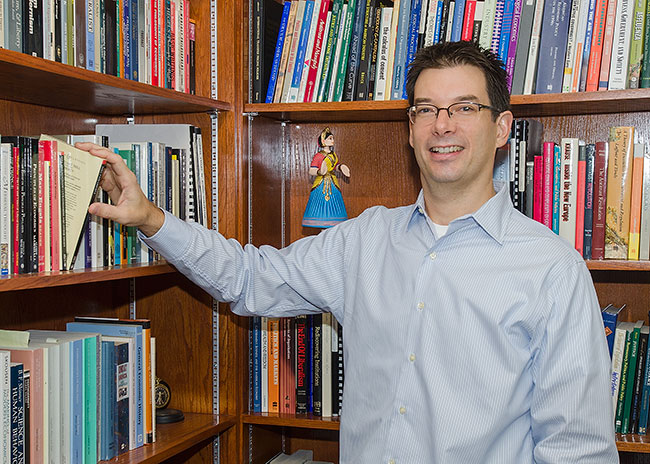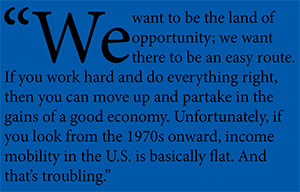Economics Professor Explores How Bigger May Not Be Better In Texas
Sept. 19, 2014
SHSU Media Contact: Jennifer Gauntt
Story By: Amy Barnett
 |
| Economics professor Mark Frank's work on income inequality has made headlines, appearing in the Dallas Morning News, Fort Worth Star-Telegram and on NPR. —Photo by Brian Blalock |
You’ve heard the phrase “everything’s bigger in Texas.” It’s something Texans often take pride in, and perhaps we have proof to back it up.
Texas ranks No. 1 in the nation in medical care—we have the largest centers for cancer research and are known to have the biggest burn centers and trauma facilities in the world.
Texas has the largest number of refineries in the U.S, which refine 85 percent of all gasoline in the country.
We live in the only U.S. state that is self-sufficient in beef, poultry and hogs; that’s “big” news for meat lovers.
Texas has the world’s biggest rodeo, largest state Capitol building, and highest speed limit (85 MPH on SH 130 between Austin and San Antonio).
Yet, the question is—is bigger always better?
Texas, by the numbers Percentage of Texans earning at least $120k in 2012: 10 Percentage of state's total income that accounted for: 50 Average amount of money made by Top 5 percent of income earners in Texas's richest cities: $2.045 million Average income of residents of Texas's poorest city (Brownsville): $31,756 |
Sam Houston State University professor of economics Mark Frank says “no.”
“Geographically, Texas is the second largest state in the U.S., smaller in size to only Alaska; the bigger the state, the more likely you are going to have pockets of poverty,” Frank said.
In Texas “pockets of poverty” are prevalent, but so are “pockets of wealth”—extreme wealth, causing what Frank calls a “huge problem of income inequality.”
“If you go back to the 1950s and 1960s, Texas has always had a high level of income inequality,” Frank said. “One of the things that is really surprising to me is how consistently unequal we’ve been; and we are no different today.”
Frank began teaching at SHSU in 2000 and started his research in income inequality, especially how it pertains to Texas, in 2005.
His work involves evaluating and compiling data released by the Internal Revenue Service and posting it on his website for other researchers to use.
According to his findings, Texans earning at least $120,875 in 2012 made up 10 percent of tax filers, but they took home 50 percent of the state’s total income. In the 1970s, the top 10 percent earned one-third of the income.
In 2012, the top 1 percent, whose income started at $459,664, made 24 percent of the state’s total income; its share was about one-third that size in the 1970s.
Texas ranks “Top 10” in all methods used to measure income inequality; in some measures, we are “Top Five.”
While other states make their way off and on these lists, Texas has remained there for decades, something Frank attributes to several things.
“If you think about Texas, think about the valley and the poverty that’s down in McAllen and Brownsville; these are some of the poorest cities in the United States,” he said. “At the same time, we have cities like Dallas, Houston and even Austin with tremendous pockets of wealth. That’s a very unusual mix.”
Some of the richest towns in the U.S. are in Texas. According to the U.S. Census Bureau, in 2011, Westover Hills, population 693, had 5 percent of its residents earning an average of $2,045,000 a year; the top 5 percent of Westlake residents brought home an average of $2,041,000.
Other larger communities in the upper echelon of income are Dallas’s University Park community and Houston’s West University. The average annual income of all families in these communities is more than $225,000.
The “income gap” grows tremendously when you compare these communities to the border towns Brownsville and McAllen.
The U.S. Census Bureau reports the median household income level among the Brownsville-Harlingen area’s 415,557 residents is $31,756; that’s $18,000 below the national average. The percentage of residents there that lives below the poverty level is 36 percent, and the unemployment rate is 12.5 percent.
While Brownsville is the poorest city in the nation, its neighboring community of McAllen comes in third.
McAllen, population 129,000, has a median household income of $33,732, with 33.4 percent of the population living below the poverty level and 12.6 percent dealing with unemployment.
“McAllen and Brownsville have been poor for a long, long time,” Frank said. “From a policy point of view, there’s a lot to talk about there in trying to help them and turn around those areas of Texas.”
One of the biggest contributors to the income gap, according to Frank, is education.
 “The gap between the number of people with high school diplomas and those with college degrees has been increasing since the late 70s,” he said. “The earnings of a college graduate compared to someone who just finished high school is a great difference, and it’s just getting bigger and bigger.”
“The gap between the number of people with high school diplomas and those with college degrees has been increasing since the late 70s,” he said. “The earnings of a college graduate compared to someone who just finished high school is a great difference, and it’s just getting bigger and bigger.”
The simple answer to “closing the gap” is for more residents in the valley to become college educated. But, Frank admits, that is much easier said than done.
“Over the past 10 to 15 years, the state has cut funding for universities, so that means universities have to charge more tuition. More tuition means it is harder for low income people to go to college,” he said. “People in the valley would see a tremendous change in their income profile if they could find a way to go to college.”
Frank’s research indicates another factor of income inequality in Texas: declining mobility, or the ability to move up or down the income distribution.
“We want to be the land of opportunity; we want there to be an easy route. If you work hard and do everything right, then you can move up and partake in the gains of a good economy,” Frank said. “But, unfortunately, if you look from the 1970s onward, income mobility in the U.S. is basically flat. And that’s troubling.”
Additional research in the study of income mobility supports Frank’s findings, showing that only 8.4 percent of children born into the bottom fifth of income distribution in 1971 reached the top fifth as an adult. A similar outcome was found for children born in 1986, where only 9 percent made the economic jump.
With mobility remaining stagnant and income inequality on the rise, Frank believes a person’s starting salary is even more important, thus pointing back to the need for higher education.
As technology continues to replace low-skilled jobs, it also continues to boost productivity and income for the more skilled and educated.
“College is expensive, there’s no doubt about it, but it pales in comparison to the benefits after college,” he said. “It’s a really good return on your investment.”
Another cited cause of income inequality is the minimum wage in Texas. While many states and cities have raised the base pay of hourly workers, elected leaders in Texas have not.
“It’s not a win-win for everybody. Certainly minimum wage can help some people, but there are costs and tradeoffs and economics debate about how big the costs are, whom they affect in terms of job loss, and other responses of employees from having to pay workers a higher wage,” Frank said. “Most economists would say, ‘if you are going to look toward a government policy for a good short-term impact on income inequality, then you are better off going with an earned-income tax credit increase because you are not going to affect the employer/employee relationship but be able to give the money directly to workers.’”
Frank continues his research in income inequality in Texas and predicts the gap between the rich and the poor will continue to grow.
While Brownsville has been getting media attention in recent months about independent space-exploration company SpaceX selecting nearby Coco Chica Beach as its new commercial launch site and creating more than 500 jobs over the next 10 years, Frank believes it will only scratch the surface of a decades long problem in Texas.
“It is a step in the right direction,” Frank said. “But that area still needs to focus on increasing its number of college graduates to see a significant impact on the issue of income inequality.”
Until that happens, Frank believes many border-town citizens will remain on or below poverty levels.
You can track Frank’s research on his website, shsu.edu/~eco_mwf/inequality.html.
- END -
This page maintained by SHSU's Communications Office
Associate Director: Julia May
Manager: Jennifer Gauntt
Located in the 115 Administration Building
Telephone: 936.294.1836; Fax: 936.294.1834
Please send comments, corrections, news tips to Today@Sam.edu.

 SamWeb
SamWeb My Sam
My Sam E-mail
E-mail

